Non-Toxic Wasp Repellent: Effective Strategies
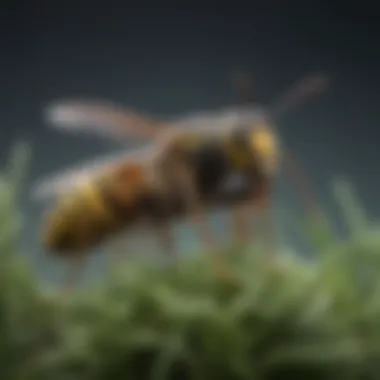
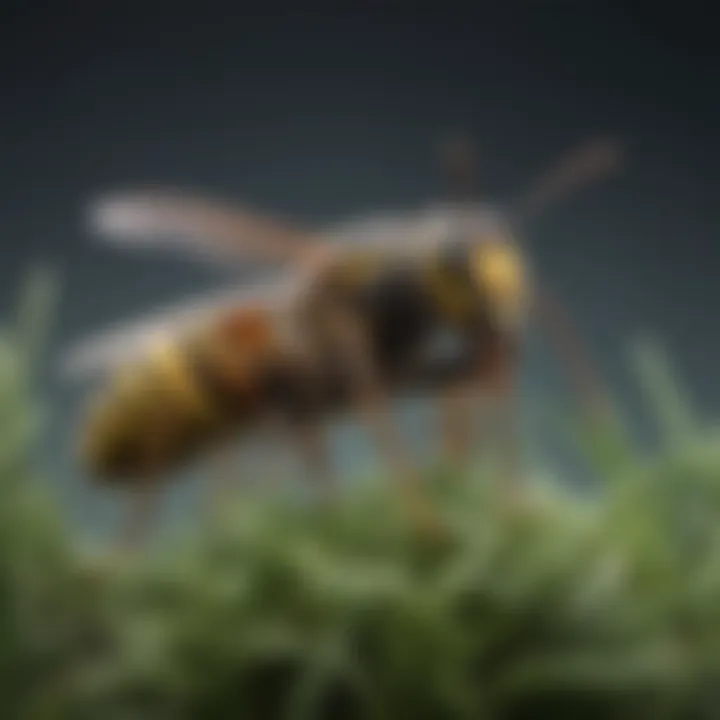
Intro
In recent years, interest in non-toxic solutions for pest control has grown significantly. Homeowners seek methods that are safe for their families and the environment. This article provides a comprehensive overview of non-toxic wasp repellents, including methods, ingredients, and best practices.
Understanding wasps and their behaviors is crucial. Wasps can be beneficial to the ecosystem, yet their presence around homes can be problematic. It is essential to approach this subject with knowledge and strategy. This guide will help housewives and homeowners identify common wasps, explore preventive measures, and create effective DIY repellent recipes.
Pest Identification
Detailed Descriptions of Common Pests
Wasps belong to the family Vespidae and are commonly found in various environments. The most recognized species include the German wasp, paper wasp, and yellow jacket.
- German Wasp (Vespula germanica):
This wasp has a distinctive yellow and black body. It often constructs nests in sheltered places, such as attics or wall cavities. - Paper Wasp (Polistes):
These wasps are generally less aggressive and can be recognized by their long, slender bodies and umbrella-shaped nests. They prefer to build nests under eaves and branches. - Yellow Jacket (Vespula):
Yellow jackets are known for their boldness and aggressive behavior. Their nests can be found underground or in wall voids.
Signs and Symptoms of Infestations
Recognizing the signs of a wasp problem is vital for timely intervention. Common indicators include:
- Visible Nests: Look for nests in sheltered areas like attics or trees.
- Frequent Wasp Sightings: Increased wasp activity near food sources or nests often indicates a nearby infestation.
- Aggressive Behavior: If wasps are constantly buzzing around your property, this may signal a nest nearby.
Prevention Strategies
Home Maintenance Tips for Pest Prevention
Keeping wasps at bay starts with proper home maintenance. Here are some helpful tips:
- Seal Openings: Inspect your home for small cracks and close them. Wasps can enter through tiny gaps.
- Remove Attractants: Old food, sweet drinks, and trash can attract wasps. Ensure these are cleaned up promptly.
- Store Food Properly: Keep food covered when eating outside or in the garden.
Natural Deterrents and Barriers
Using natural repellents can significantly reduce wasp activity. Effective deterrents include:
- Cucumber: Placing cucumber slices near wasp-prone areas can act as a natural repellent.
- Peppermint Oil: Mixing peppermint oil with water and spraying the mixture around the perimeter of your home can deter wasps due to its strong aroma.
- Plastic Decoy Nests: Hanging a fake nest can discourage wasps from establishing a new nest nearby, as they tend to be territorial.
Treatment Options
Overview of Chemical vs. Natural Treatments
While chemical treatments might offer immediate relief, they often have harmful effects on the ecosystem. Natural treatments are typically safer for both humans and beneficial insects.
Step-by-Step Guides for DIY Treatments
Creating your own wasp repellent is a straightforward process. Here are two effective DIY recipes:
- Peppermint Spray:
- Vinegar Trap:
- Ingredients:
- Instructions:
- 1 cup of water
- 10 drops of peppermint essential oil
- Combine water and peppermint oil in a spray bottle. Shake well and spray in areas where wasps are prevalent.
- Ingredients:
- Instructions:
- Apple cider vinegar
- A glass jar
- Plastic wrap
- Rubber band
- Pour apple cider vinegar into the jar. Cover the top with plastic wrap and secure it with a rubber band. Poke small holes so wasps can enter but cannot escape.
By adopting these measures, homeowners can maintain a safer environment while respecting local wildlife.
"Natural approaches not only guard against pests but also protect helpful insects and the surrounding ecosystem."
Non-toxic solutions are becoming an essential aspect of modern pest management. Educating oneself on how to identify, prevent, and treat wasp issues ensures a balanced coexistence with nature.
Preface to Non-Toxic Wasp Repellents
The significance of using non-toxic wasp repellents cannot be overstated, especially among homeowners and individuals concerned about safety. Traditional chemical methods are often effective but they can pose hazards to both humans and pets. This article delves into non-toxic approaches that provide a safer alternative for controlling wasps, focusing on their effectiveness and environmental impact.
Natural repellents serve multiple benefits. They are safer for residential use, reducing the risk of unintended harm to children and animals. Furthermore, these products often utilize readily available ingredients, making them more accessible. For house owners looking for sustainable options, non-toxic methods align well with eco-conscious practices in pest management.
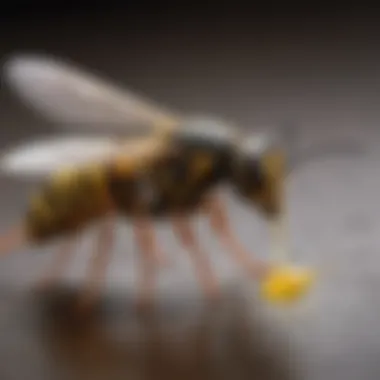
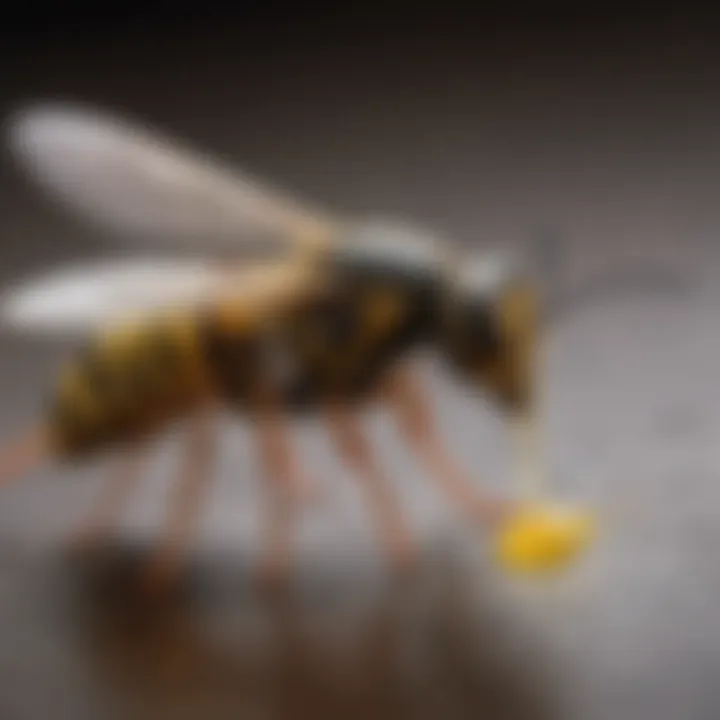
Despite their advantages, it is crucial to recognize that non-toxic solutions may not offer an instantaneous impact like commercial chemicals. As understanding grows regarding wasp behaviors and what attracts them, this guides the development of more efficient non-toxic strategies. This article addresses these aspects, ensuring readers grasp the various facets of non-toxic wasp management for a well-rounded perspective.
Understanding Wasp Behavior
Wasp behavior is deeply tied to how we approach their control. Wasps, being social insects, operate within a well-defined colony structure, which influences their food preferences and nesting habits. An understanding of their life cycle is essential in crafting effective deterrents. For example, they typically seek food that consists of proteins and sugary substances, especially during late summer when food sources become scarce.
Observing wasps can provide insight into their nesting preferences and patterns. They often build nests in sheltered areas, such as eaves or tree branches, leading to potential encounters with individuals going about their daily activities. Recognizing where they are likely to establish their colonies allows homeowners to take preemptive measures to not only repel but also discourage nesting in the first place.
Effective non-toxic repellents depend on this behavior understanding. For instance, the timing of application is key. Applying repellents well before wasps become aggressive can make interactions smoother. Knowing about their attraction to specific scents or food items can also help in employing strategic non-toxic measures.
The Need for Non-Toxic Solutions
The environment faces challenges from the widespread use of chemical insecticides, raising concerns about their long-term ecological impact. Shifting to non-toxic solutions presents a practical and responsible option for pest management. Many householders today aim to minimize their ecological footprint, making non-toxic repellents an appealing choice. They reduce the risk of chemical runoff that can impair plants, animals, and water systems.
Additionally, unforeseen side effects from traditional pesticides include the development of resistance among pest populations, making them harder to control over time. Non-toxic repellents often utilize a broader array of ingredients like essential oils and other natural components, which is less likely to induce such resistance.
Health is another pivotal concern. Many families prefer non-toxic solutions for their pest control needs because they want to protect their loved ones. Chemical exposure can lead to health issues, particularly in children or pets who may be more sensitive to such compounds. With non-toxic repellents, homeowners can enjoy peace of mind, knowing they have opted for methods that prioritize safety.
Ingredients in Non-Toxic Wasp Repellents
The choice of ingredients in non-toxic wasp repellents is critical for effective pest control. Using natural components reduces risks associated with chemical exposure, making it safer for people, pets, and the environment. Non-toxic ingredients can disrupt wasp behavior or deter their presence without harming them.
Essential Oils
Essential oils serve as a foundation for many non-toxic wasp repellents due to their strong fragrances and natural properties. They can interfere with a wasp's sense of smell, causing disorientation and discouraging their approach.
Peppermint Oil
Peppermint oil is well-known for its refreshing scent and powerful properties. It contains menthol, which acts as a natural repellant. This oil creates an environment that is unwelcoming for wasps, making it a popular option for homeowners.
The key characteristic of peppermint oil is its strong aroma. This is beneficial because it can mask the scents that attract wasps, such as certain food odors. A unique feature of peppermint oil is that it can also be pleasant for humans. However, it is essential to dilute the oil with a carrier solution to avoid skin irritations for sensitive individuals.
Lemongrass Oil
Lemongrass oil is another powerful ingredient in wasp repellents. This oil contains citronella, a compound that acts to repel various insects, including wasps. The key characteristic of lemongrass oil is its citrusy fragrance, which is pleasing to many people yet unappealing to wasps.
One unique feature of lemongrass oil is its versatility in various formulations. It can be blended with other essential oils for enhanced effectiveness. However, an advantage is that it requires frequent reapplication to maintain efficacy, especially in outdoor environments.
Eucalyptus Oil
Eucalyptus oil is recognized for its strong scent and medicinal properties. It serves as an effective deterrent against wasps due to its sharp aroma. The key characteristic of eucalyptus oil is its ability to produce a potent smell that masks food odors and can deter wasp presence.
A unique feature of eucalyptus oil is its ability to work well in different formulations, whether used in sprays or combined with other essential oils. An advantage is its natural antioxidant properties, although it may cause allergic reactions in some individuals, so caution is recommended when using it in close proximity to others.
Vinegar and Water Solutions
Vinegar solutions are simple yet effective. Mixing vinegar with water in a spray bottle can create an unpleasant environment for wasps. The acetic acid within vinegar disrupts the pests' sensory perceptions, essentially making the area less inviting. This method has the advantage of being cheap and easy to prepare.
Citrus-Based Repellents
Citrus-based repellents are another effective non-toxic option. The natural oils extracted from citrus fruits, such as oranges or lemons, can deter wasps. Their fresh, zesty scent is often associated with cleanliness and can drive away unwanted insects. However, citrus deterrents may need to be reapplied frequently.
Natural Deterrents
Natural deterrents like garlic and pepper serve as additional allies for non-toxic wasp management. These ingredients are abundant and can often be found in most households.
Garlic
Garlic is known for its strong smell, which functions as a natural insect repellent. The specific aspect of garlic in wasp control is its ability to repel by scent. Garlic's pungency is considered a beneficial attribute, as wasps typically avoid it. A unique feature of garlic is its availability, making it easy to implement in various forms, be it fresh cloves or garlic powder. However, it may require frequent application to remain effective, especially in outdoor settings.
Pepper
Pepper, particularly cayenne pepper, is another effective non-toxic solution. The heat from pepper creates an uncomfortable environment for wasps. Its key characteristic is its ability to irritate wasps, making it an excellent addition to repellents. An advantage of using pepper is that it is readily available and inexpensive. However, it may wash away or lose potency in wet conditions, necessitating regular reapplication.
The combination of these ingredients ensures a multi-faceted approach to wasp repellent strategies, yielding effective results without reliance on harsh chemicals.
DIY Non-Toxic Wasp Repellent Recipes
Creating your own non-toxic wasp repellent offers several advantages, particularly for those looking for safer pest control solutions. The availability of natural ingredients in the household makes it easier to formulate remedies without the need for harmful chemicals. These recipes allow users to customize the ingredients, ensuring that they cater to specific needs and preferences. DIY solutions are not only cost-effective but also environmentally friendly. As homeowners take more control in their pest management strategies, making effective repellents at home can empower them and contribute to achieving a wasp-free outdoor space.
Simple Water and Vinegar Mixture

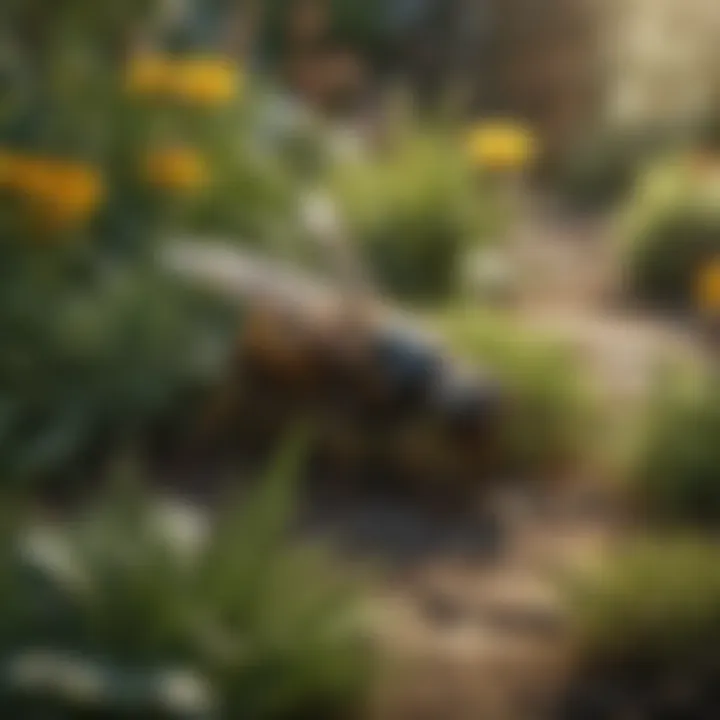
A simple water and vinegar mixture serves as an accessible starting point for creating a non-toxic wasp repellent. The acidic nature of vinegar can disrupt the scent signals wasps rely on. To prepare this mixture, combine equal parts of water and vinegar in a spray bottle. Use white vinegar or apple cider vinegar, based on personal preference. Shake well before application to ensure that the ingredients are well blended.
When applying this solution, it’s a good practice to do it early morning or late evening when wasps are less active. Spray the mixture around areas where wasps tend to gather, such as patios or garbage bins. The primary advantage of this method is how quick and easy it is to prepare. It is important, however, to note that this solution might require frequent reapplication, especially after rain.
Essential Oil Blend
Another effective option is an essential oil blend. Essential oils, known for their strong scents, can deter wasps effectively. Popular choices include peppermint, eucalyptus, and lemongrass oils. To create a blend, mix about 10 drops of essential oil with water in a spray bottle. Consider adding a few drops of liquid soap to help the mixture adhere to surfaces better.
This approach not only repels wasps but also leaves a pleasant fragrance in the area. The application should follow a similar schedule as the vinegar mixture, emphasizing early morning or late evening. Be cautious to test a small area before larger application, as some surfaces might react negatively to essential oils.
Homemade Wasp-Trap Solutions
For those who prefer trapping over repelling, homemade wasp traps can be a practical solution. Creating these traps requires basic supplies, such as an empty plastic bottle, sugar, and water. Cut the top third of the bottle off and invert it into the bottom two-thirds, creating a funnel. Fill the bottom part with a mixture of water, sugar, and a splash of vinegar to attract the wasps. The sweet scent will draw them in, while the vinegar helps in deterring them from escaping.
Place these traps in strategic locations, such as near picnic areas or entry points to gardens. Regularly check the traps and reset them as needed to maintain their effectiveness. While not a preventative measure on their own, these traps can help manage wasp populations around your space.
"Taking a proactive approach through DIY repellents helps homeowners create a safer environment while also being more in control of their pest management."
In summary, these DIY recipes enable homeowners to address wasp problems naturally and effectively. Whether opting for vinegar solutions, essential oils, or traps, the approach promotes safety while discouraging unwanted pests from invading spaces.
Application Techniques for Non-Toxic Repellents
Effective application techniques are critical in maximizing the efficacy of non-toxic wasp repellents. Proper strategies can enhance the performance of these natural solutions, providing homeowners with greater control over wasp activity around their living spaces. Understanding how to apply these repellents effectively can result in a more pleasant outdoor experience and reduce the risk of wasp encounters.
Timing and Weather Considerations
Timing when applying non-toxic repellents plays a vital role in their effectiveness. Wasp activity varies throughout the day and across different seasons. Generally, wasps are most active during warm weather and midday hours. It is advisable to spray repellents early in the morning or later in the afternoon when the wasps are less active. This timing reduces the chance of encountering aggressive wasps during application.
Weather conditions like wind and rain also influence application outcomes. Wind can disperse the repellent away from the target area. Thus, calm weather conditions are ideal for effective application. Rain can wash away the repellent, making reapplication necessary soon after a rain event. Homeowners should monitor forecast conditions and plan applications accordingly to ensure repellents have the highest chance of success.
Application Tools
Choosing the right application tool is essential for ensuring that non-toxic wasp repellents reach their intended targets effectively. Two common application tools are spray bottles and cloth absorption methods.
Spray Bottles
Spray bottles offer a straightforward and effective way to apply non-toxic wasp repellents. The key characteristic of spray bottles is their ability to deliver a fine mist, allowing for even distribution over targeted areas. This makes them particularly beneficial for reaching nests or areas where wasps congregate.
A unique feature of spray bottles is their adjustable nozzle. This nozzle allows users to switch between different spray patterns – from a fine mist to a more concentrated stream. This flexibility can be advantageous in different scenarios, such as applying directly onto nests or covering wider outdoor areas.
However, one potential drawback is that it requires manual effort. Some individuals may find it tiring to use spray bottles over extended periods. Nevertheless, their convenience and ease of use make them a popular choice for applying non-toxic solutions effectively.
Cloth Absorption
Cloth absorption methods present another practical option for applying non-toxic wasp repellents. This technique involves soaking a cloth in the repellent and then strategically placing it in areas where wasps are active. The key characteristic of this method is its simplicity and the reduction of overspray, making it useful in smaller spaces or enclosed areas.
One unique feature of cloth absorption is that it allows for longer-lasting applications. The cloth can retain the repellent, gradually releasing it over time. This sustained effect can help deter wasps without the need for frequent reapplication. However, the effectiveness may decrease in damp conditions, as moisture can dilute the repellent on the cloth.
In essence, both spray bottles and cloth absorption methods contribute to the overall goal of effective wasp management with non-toxic solutions. By carefully considering timing, weather, and application tools, homeowners can enhance the effectiveness of their repellent strategies.
Efficacy of Non-Toxic Wasp Repellents
The efficacy of non-toxic wasp repellents is crucial for understanding their role in sustainable pest management. Unlike traditional chemical alternatives, these natural solutions aim to minimize harm to the environment while still providing effective protection against wasps. Homeowners seek reassurance that the products they use will not only deter pests but also keep their surroundings safe for pets and children. Evaluating effectiveness involves several elements, including active ingredients, environmental conditions, and application methods.
Factors Influencing Effectiveness
Several factors impact how well non-toxic wasp repellents perform. These include:
- Concentration of Ingredients: Higher concentrations of natural repellents, such as essential oils, may yield better results. For instance, peppermint oil is known for its strong scent and can effectively drive wasps away when used in sufficient amounts.
- Environmental Conditions: Factors like humidity, temperature, and wind can alter the effectiveness of repellents. A solution might work well in calm conditions but lose its potency in a breezy environment.
- Type of Wasp Species: Different species of wasps may respond variably to certain repellents. Understanding the specific wasp population is vital in choosing the right approach.
- Application Technique: Methods of application can significantly influence outcomes. Spraying directly at the nests or along common flight paths is generally more effective than scatter application.
Comparative Analysis Against Chemical Options
When comparing non-toxic to chemical wasp repellents, it is essential to consider both efficacy and environmental impact. Chemical solutions often provide rapid results but come with several drawbacks:
- Immediate but Short-Lived Effects: Chemical repellents typically act more quickly than their non-toxic counterparts but may require frequent reapplication.
- Health Risks: The use of chemicals raises concerns about potential health risks for humans and animals, especially in enclosed spaces.
- Environmental Impact: Chemical repellents can lead to unintended harm to beneficial insects and local ecosystems. In contrast, non-toxic options are generally safe and promote a more balanced environmental approach.
Preventative Measures to Reduce Wasp Attraction
Preventing wasp attraction is crucial in managing their populations around homes and outdoor areas. By addressing the factors that draw these insects to your premises, you can significantly reduce their presence. The aim here is to create an unfavorable environment for wasps, thus encouraging them to seek shelter elsewhere. These measures should complement the use of non-toxic repellents, creating a comprehensive strategy for pest management.

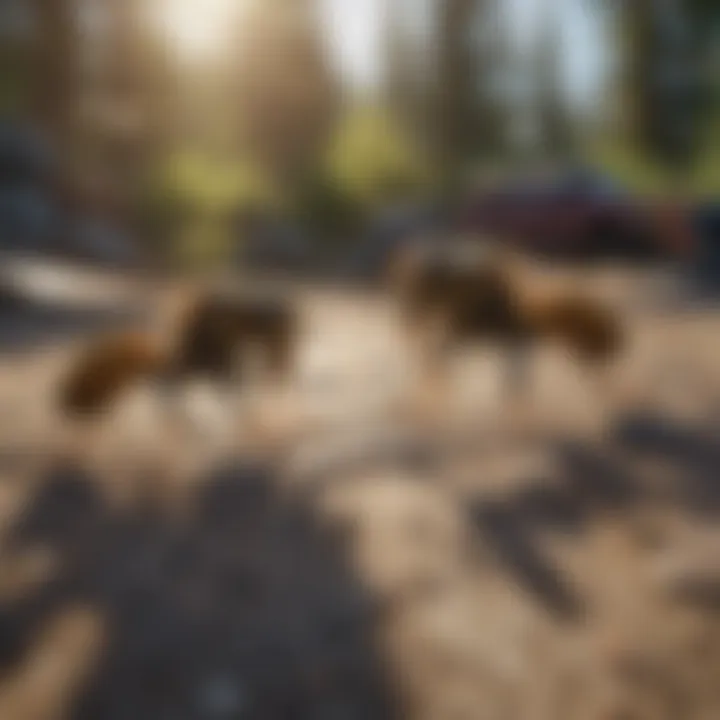
Proper Food Storage and Waste Management
Food sources are one of the primary attractants for wasps. Proper food storage is essential in avoiding unnecessary pest problems. It is vital to keep food in airtight containers. This applies not only to human food but also pet food. Outdoor trash bins should be secure. Lids must close tightly. A good practice is to line trash cans with a heavy-duty bag that can be tied shut, preventing odors from escaping.
Additionally, cleaning up spills and crumbs promptly is crucial. Frequent garbage collection, especially in warmer months, helps. It is advisable to use bins that contain odor-neutralizing features. Making your environment less inviting to wasps can greatly reduce their numbers.
"An ounce of prevention is worth a pound of cure."
Nest Management and Removal
Managing wasp nests is critical in preventing wasp attraction. First, it is important to identify any existing nests around your property. Look for nests in sheltered areas such as eaves, attics, and bushes. If you find any nests, consider your options carefully.
If the nest is small and accessible, removal may be possible. For safety, do this at night when wasps are less active. Wear protective clothing and consider using a non-toxic repellent during the removal process.
If the nest is large or in a difficult location, it may be best to consult a pest management professional. Removing nests will limit not only the immediate population but also potential future attractants.
Case Studies: Successful Non-Toxic Repellent Applications
In the context of this article, case studies serve as critical real-world illustrations of how non-toxic wasp repellents can be effectively utilized. They offer insights into practical applications, demonstrating the practicality and efficacy of these natural solutions. By examining various scenarios where non-toxic repellents have been employed successfully, we can gather valuable lessons on their benefits and limitations. This information provides homeowners and pest management professionals with the confidence needed to adopt non-toxic strategies, knowing that others have reaped rewards from similar approaches. The compelling narratives from these case studies also highlight the potential for sustainable pest management that minimizes environmental impact while maintaining effectiveness against wasps.
Residential Case Study
A residential case study conducted in a suburban location revealed the effectiveness of a peppermint oil-based repellent. The homeowner, concerned about the proximity of a wasp nest near their outdoor dining area, opted for a mixture of water and peppermint oil. The mixture was applied regularly during warm afternoons when wasp activity peaked. The immediate impact was notable; the wasps showed a marked decrease in activity around the treated area.
Moreover, the homeowner reported heightened comfort levels during outdoor meals, allowing the family to enjoy their space without frequent disturbances. This case emphasizes the ease of implementing a DIY approach, encouraging homeowners to experiment with natural ingredients available at home.
"Natural solutions not only keep wasps away but also enrich our gardens and homes with pleasant scents."
Commercial Application Insights
In a commercial setting, a local café on the coast illustrated a proactive approach to managing wasps using a combination of vinegar and water as a repellent. The café owner faced complaints from patrons about wasp intrusions during lunch hours. To address the issue, a regular spraying schedule was instituted, utilizing a simple solution of vinegar mixed with water, targeting areas around trash bins and dining spaces.
The results were striking; over a few weeks, the café noted a significant reduction in wasp presence, leading to improved dining experiences for guests. Comments of satisfaction increased on social media, showcasing the café's commitment to a safe and comfortable environment. This case underscores how businesses can adopt non-toxic repellent methods and achieve not only customer satisfaction but also promote an image of care for sustainability.
By sharing these success stories, we inspire further exploration of non-toxic wasp repellents, validating their practicality in domestic and commercial environments.
Potential Limitations of Non-Toxic Repellents
Understanding the potential limitations of non-toxic wasp repellents is essential for homeowners seeking effective pest management strategies. While these natural alternatives offer various benefits, awareness of their shortcomings can help set realistic expectations and guide appropriate usage. This section will delve into the duration of efficacy and effectiveness in varying conditions to provide a comprehensive view of non-toxic repellents.
Duration of Efficacy
The duration of efficacy is a crucial aspect when considering non-toxic wasp repellents. Unlike chemical solutions that may provide longer-lasting protection, natural ingredients often require frequent reapplication. For instance, essential oils such as peppermint or eucalyptus may lose their potency after exposure to sunlight or rain. Therefore, it is important for users to apply these repellents regularly, especially after weather changes.
In practical terms, monitoring the effectiveness of these repellents involves observing wasp behavior. If wasps are spotted frequently, this may indicate that the repellent is losing its effectiveness. Homeowners should consider seasonal changes as well, since wasp activity tends to vary throughout the year. Non-toxic solutions may be necessary to apply more often during peak wasp activity months to maintain an effective barrier.
Effectiveness in Varying Conditions
Another significant limitation is the effectiveness of non-toxic repellents under varying environmental conditions. Factors such as temperature, humidity, and wind can dramatically impact how well these substances work. For example, high humidity may dilute essential oils and reduce their efficacy, while strong winds can disperse the scent, rendering the repellent less effective.
Furthermore, specific outdoor settings may also influence how well non-toxic repellents perform. Areas with dense foliage or established wasp nests may require stronger or more concentrated applications due to increased wasp activity. On the other hand, open spaces might allow for better dispersal of the natural ingredients, thereby enhancing their effectiveness.
Non-toxic repellents can be likened to a soft approach in pest management. While they are safer for the environment and do not pose health risks to humans or pets, they may not always provide the same level of rapid control as traditional chemical alternatives. It is essential for homeowners to balance their desire for natural solutions with the effectiveness required for their specific situation.
Understanding these limitations can empower homeowners to make informed decisions about using non-toxic wasp repellents, ensuring they are better prepared for effective application strategies.
Epilogue
Summarizing the topic of non-toxic wasp repellents highlights their importance in modern pest management strategies. While traditional chemical solutions often prioritize immediate effectiveness, they can pose risks to human health and the environment. A shift towards non-toxic methods ensures that safety and sustainability can coexist. These methods leverage natural ingredients that are typically harmless to humans and pets, promoting a healthier living environment.
Summarizing Non-Toxic Benefits
The benefits of non-toxic wasp repellents are several. Most notably, they minimize health risks associated with chemical exposure. Households using non-toxic options can feel more secure, especially in homes with children or pets. Additionally, these options are more environmentally friendly. They do not contribute to the pollution of air and water, a significant concern with chemical pesticides.
Moreover, natural repellents can be just as effective as their chemical counterparts when applied appropriately. For instance, essential oils like peppermint have demonstrated their ability to repel wasps effectively. This encourages homeowners to experiment with DIY recipes that not only serve as repellents but also contribute to a more sustainable lifestyle.
- Health Safety: Non-toxic formulas reduce the risk of allergic reactions and other health issues.
- Environmental Impact: These products support biodiversity and do not harm beneficial insects.
- Cost-Effectiveness: Many ingredients can be found in the home already, reducing the need for purchased products.
Future Directions in Wasp Management
As society becomes increasingly aware of the ecological footprint of its habits, the future of wasp management will likely see a significant emphasis on sustainable practices. Research into non-toxic alternatives is expected to gain traction. This may lead to the discovery of new natural compounds that exhibit repellent properties.
Future initiatives may also include better education on wasp behavior, helping homeowners understand prevention strategies that reduce attractiveness to these pests. Digital platforms and community resources can play a pivotal role in spreading awareness and tips for effective wasp control.
- Collaborative Efforts: Local municipalities could work together with pest control experts to provide resources and seminars aimed at educating the public.
- Research Funding: Increased funding into organic compounds may yield new solutions that are even more effective against various pest species.
- Community Engagement: Social media forums, such as those found on Reddit or Facebook, can serve as platforms for sharing personal experiences and effective homemade solutions.
The trajectory toward non-toxic wasp management is encouraging. It promotes a healthier relationship with our environment while still addressing the legitimate concerns posed by these pests. As consumers demand safer options, the market is likely to respond positively, paving the way for innovation in non-toxic repellent strategies.



